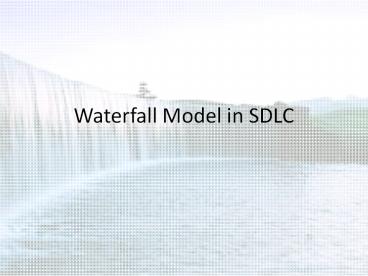Waterfall Model in SDLC - PowerPoint PPT Presentation
Title:
Waterfall Model in SDLC
Description:
These PPT presentations help to understand waterfall model in SDLC. The Waterfall model is the earliest SDLC approach that was used for software development. There are five steps in the waterfall model – PowerPoint PPT presentation
Number of Views:4406
Title: Waterfall Model in SDLC
1
Waterfall Model in SDLC
2
INTRODUCTION
- A software development process or life cycle is a
structure imposed on the development of a
software product. There are several models for
such processes, each describing approaches to a
variety of tasks or activities that take place
during the process.
3
Types of Software development models
- Waterfall model
- V model
- Incremental model
- RAD model
- Agile model
- Iterative model
- Spiral model
4
Waterfall Model
- There are total 7 models in software development.
Waterfall model is a popular model of the system
development life cycle. It is very simple to use
and understand. In a waterfall model, each phase
must be completed before the next phase can begin
and there is no overlapping in the phases.
5
(No Transcript)
6
Steps in Waterfall Model
- Requirements Requirements is the initial step in
waterfall model. All possible requirements of the
system to be developed are captured in this phase
and documented in a requirement specification
document. In this steps user demands the entire
requirement for the software development.
7
- Design This is the second step in waterfall
model. This system design helps in specifying
hardware and system requirements and helps in
defining the overall system architecture.
8
- Implementation It is very important part of
waterfall model. After requirements and design
the next step in implementation. With inputs from
the system design, the system is first developed
in small programs called units, which are
integrated in the next phase. Each unit is
developed and tested for its functionality, which
is referred to as Unit Testing. The main purpose
of these steps is to execute the program.
9
- Verification In these steps the entire systems
will be tested for any faults and failures. Once
the functional and non-functional testing is done
the product is deployed in the customer
environment or released into the market.
10
- Maintenance In these last steps there are some
issues which come up in the client environment.
In this steps the issue will be fixed, patches
are released. Maintenance is done to deliver
these changes in the customer environment.
11
(No Transcript)
12
Advantages
- This model is simple and easy to understand and
use. - It is easy to manage due to the rigidity of the
model each phase has specific deliverables and
a review process. - In this model phases are processed and completed
one at a time. Phases do not overlap. - Waterfall model works well for smaller projects
where requirements are very well understood
13
Disadvantages
- Once an application is in the testing stage, it
is very difficult to go back and change something
that was not well-thought out in the concept
stage. - No working software is produced until late during
the life cycle. - High amounts of risk and uncertainty.
- Not a good model for complex and object-oriented
projects.
14
- Poor model for long and ongoing projects.
- Not suitable for the projects where requirements
are at a moderate to high risk of changing.
15
Uses of Waterfall Model
- This model is used only when the requirements are
very well known, clear and fixed. Product
definition is stable. - Technology is understood.
- There are no ambiguous requirements
- Ample resources with required expertise are
available freely - The project is short.
16
- Visit us for help
- http//hndassignments.co.uk/
- Like us on Facebook
- https//www.facebook.com/hndassignmentsuk
- Tweet us
- Twitter.com/Locusrags































